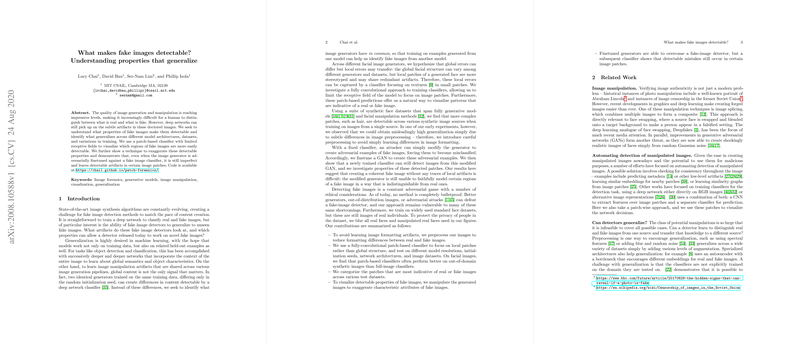Analysis of "What makes fake images detectable? Understanding properties that generalize"
This paper by Chai et al. investigates the properties of fake images that allow them to be discerned by computational means, despite their increasing visual fidelity. It addresses a critical challenge in the domain of image forensics: the detection and generalization capabilities of classifiers across various generative models and datasets. The paper leverages a patch-based classification method to identify local artifacts indicative of image manipulation and synthesis, and examines the robustness of these methods in the face of adversarial fine-tuning.
Methodological Approach
The researchers employ fully convolutional networks with constrained receptive fields to detect local textures in small image patches rather than relying on global image attributes. This patch-focused analysis is designed to pick up on stereotyped features within small sections of images that are consistent across different models and datasets. Experiments utilize a diverse range of generative models, including PGAN, SGAN, and Glow, as well as manipulation techniques within the FaceForensics++ dataset, to thoroughly test the generalization potential of these classifiers.
A strategic preprocessing protocol is applied to prevent the model from learning non-essential preprocessing differences. This involves ensuring that both real and synthetic images undergo similar transformations prior to classification to isolate forensic signals from preprocessing artifacts.
Core Findings and Results
The paper reveals several important findings:
- Generative Models: Classifiers trained on images from one generative model showed varying degrees of success when applied to images from other generators. Notably, patch-based classifiers demonstrated enhanced generalization capabilities as compared to full-image classifiers, especially when generalized to different datasets such as FFHQ.
- Adversarial Robustness: Even when generators were adversarially finetuned to evade detection, patch classifiers retained the ability to detect subtle inconsistencies. This suggests an intrinsic difficulty for synthetic models to eliminate all detectable local artifacts.
- Local Artifact Detection: The analysis of which image patches contributed most to successful classification revealed that complex textures, such as hair and expressions, were often the most informative for detecting generative model outputs. Visualization techniques showed that classifiers typically focused on these textured regions rather than global structural cues.
- Facial Manipulation Tasks: On the FaceForensics++ dataset, local classifiers maintained strong detections without explicit supervision of manipulated regions, indicating the utility of patch-based approaches across both fully generative and partial manipulation contexts.
Implications and Future Directions
The methodologies and findings presented in this paper have significant implications for the ongoing development of image forensic techniques. The insights into patch-based classification challenge previous notions of focusing solely on global frameworks and suggest a shift towards leveraging detailed local analysis for detection of falsifications. Furthermore, recognizing that texture preservation is a critical flaw in current generative models can redirect efforts in both image synthesis and forensics.
Future work should seek to leverage these findings to enhance the robustness of forensic tools against ever-improving generative adversarial networks (GANs) and other image synthesis technologies. Additional research could also explore further improving generalization to novel models through the integration of multi-patch datasets or real-time learning systems capable of adapting to new types of artifacts as they emerge.
Conclusion
Chai et al.'s paper makes a robust contribution to the field of image forensics by dissecting the detectability of fake images and proposing effective methods that generalize across model architectures and datasets. The patch-focused approach represents a notable pivot in forensic methodologies and underscores the complexity of creating synthetic images devoid of detectable local artifacts. Such research continues to play a pivotal role in understanding and countering the challenges posed by sophisticated generative technologies.
